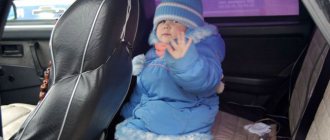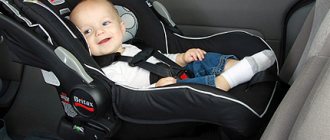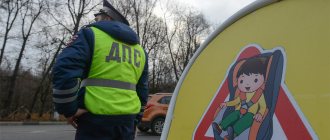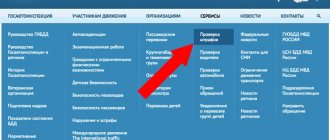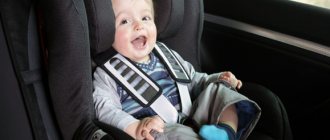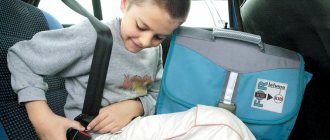Penalty for not having a child seat
The regulatory act of traffic rules, paragraph 22.9, sets out the rules that must be followed when a child is in the car, in the front or rear passenger seat.
The following standards must be observed:
- up to seven years - travel in the back and front seats and with full fixation using a cradle or car seat;
- being in a seat and secured with belts is mandatory, even for short trips;
- for children from 7 years to 12 years, and large children who do not fit in a seat can be transported without a seat only in the rear seats of the car;
- The cradle or chair is selected according to age and weight.
For violation of these rules, an administrative fine is imposed for a child without a chair - 3,000 rubles in all regions, in accordance with Article 12.23 of the Administrative Code.
For leaving a child under 7 years old in the car, the penalty amount is 2,500 rubles for residents of Moscow and St. Petersburg, and 500 rubles for other regions (Clause 1.Article 12.19 of the Administrative Code).
Traffic police requirements for child seats
Lawmakers have reformed child transportation regulations over the past few years. In the past, drivers have complained about the strict age regulations in place. The fact is that children who grew faster than their peers did not fit into a child seat, and therefore they had to be seated as ordinary passengers, for fear of liability for failure to comply with traffic rules.
Now, the traffic police have solved this problem - children from 7 years old can, with the consent of their parents, sit without a seat, but only in the back seat. Children under 12 years of age are still not allowed to ride in the front seat without a child seat. In addition, the chair itself must be selected according to the weight and height of the child in order to ensure maximum safety for him.
Fine for ordinary people, officials and legal entities
The fine for not having a child seat varies depending on who committed the offense:
| Responsible person | Amount of fine in rubles |
| Driver (Parents, relatives) | 3 000 |
| Officials – educators, teachers, taxi drivers | 25 000 |
| Legal entities – school, taxi company | 100 000 |
It is possible to pay the fine with a 50% discount within 20 days from the date of delivery of the decision to the citizen.
Fine for an unbelted child
In 2007, fines for not having a child seat began to be applied, and warnings began to be issued much earlier. More precisely, they were punished for not having a child restraint in the car when transporting a child.
Important! Later, the rules only became stricter, and from 2021 it is only allowed to use child seats or boosters (if the child is over 7 years old but under 12).
The previously very popular seat belt fasteners (adapters for standard seat belts) will now still attract a fine, since they have not passed mandatory certification by the State Traffic Safety Inspectorate.
Universal transformable chair
If we talk about the punishment for drivers that can be imposed for not having a child seat in the car when transporting children, it is regulated by the Code of Administrative Offences. A measure that can be imposed by a traffic police inspector is a fine. What is the fine for an unbelted child?
The fine for a child without a seat in 2021 is:
- for individuals 3000* rubles;
- officials who control the transportation of one or a group of children are fined more seriously - up to 25,000 rubles*;
- A legal entity may be fined for a child seat of up to 100,000 rubles*.
Accordingly, it becomes clear that the amounts of fines are quite large, which gives full confidence that they can amount to up to 50% of the cost of the chair itself (market average). Therefore, even the most budget models (and they are subject to no less number of safety checks) will already pay for their expenses in just two stops by a traffic cop.
Note! The twenty-day rule applies to this type of punishment. If the offending driver manages to pay within 20 days of receiving the order, he will be given a 50% discount from the state. But if the fine for an unbelted child is repeated, then the full amount is paid.
We suggest you read: How to prove paternity and apply for child support
By the way, another measure applicable to drivers is when a beloved child is left alone in the car, unattended. Our country has taken measures to punish careless motorists, and the reason is the frequent deaths of children around the world from such carelessness.
Article 12.19 of the Code of Administrative Offenses directly states that leaving a child under 7 years old alone in a car is punishable by a penalty of 500 rubles*.
Important! This rule is even stricter for Muscovites and St. Petersburg residents, where this offense is punished more seriously: 2,500 rubles*.
At what age should children be transported in special seats?
Transportation of children under 12 years of age must be carried out in accordance with traffic regulations (clause 22.9)
The main provisions of this regulatory legal act:
- Fixing belts and a seat are a prerequisite for transportation. Other devices, including homemade ones, cannot be used in 2021, this is noted in the traffic rules.
- In the back seat, without using a seat, but with securing belts, you can seat a child from 7 years old.
- Placing children on motorcycles is strictly prohibited.
The driver of the vehicle is also fined if:
- the minor is in the seat, but is not wearing a seat belt;
- two children were seated in one standard chair;
- the child is fastened, but is in the arms of an adult;
- the child is large and the purchased chair does not fit;
- The car is not equipped with standard securing belts.
For transporting children without a seat, a fine is imposed after drawing up a report on the offense.
If several children are traveling in a car, and all of them are without a car seat, then a standard fine is imposed - 3,000 rubles, since only one offense was recorded. You can avoid a fine when transporting children over 7 years old by using a special seat with a belt - a booster.
The inspector does not have the right to impose a penalty if the car was not moving, for example, standing in the parking lot.
Types of restraint devices
Child seats are needed for everyone under 150 cm and less than 36 kg, and are transported in the front seat. The use of a seat in the rear seat is mandatory for children under 7 years of age.
In total, there are 5 groups of child restraint devices, divided according to the child’s weight:
- Group 0 is intended for children up to 10 kg;
- Group 0+ is intended for children up to 13 kg;
- Group 1 for children from 9 kg to 18 kg;
- Group 2 for children from 15 kg to 25 kg;
- Group 3 for children from 22 kg to 36 kg.
More on the topic: Is it possible to challenge a fine if there is no photo recording sign?
Please note that the previously popular adapters for standard FEST belts are not child restraint devices. Since July 12, 2017, they have been effectively banned, since the license of the company producing them was taken away. Based on test results, this type of restraint is found to be unsafe for children. Thus, the inspector will quite reasonably fine the driver who is trying to replace a standard seat for transporting a child with a FEST adapter.
But boosters are allowed for use, and the inspector will not fine you for their use, but provided that the child is over 7 years old.
These devices are needed to ensure that the standard car belt passes over the chest and not over the neck of a small passenger. It will not be a big secret that for these purposes it is possible to use a regular pillow under the butt. But let us note once again that this is for older girls and boys.
As a rule, child seats are attached to the seat using standard belts, and the child is held in place by the belts of the car seat itself (ISOFIX system). If the device does not have its own belts, the child is held and secured using standard belts according to the instructions.
Taxi fine if a child is without a seat
Taxi drivers can be brought not only to administrative, but also to criminal liability under Article 238 of the Criminal Code “... provision of services that do not meet safety requirements.” However, this measure is rarely taken. Most often, both the driver and the owner of the taxi company - a legal entity - are fined.
According to administrative legislation, a driver who violates transportation rules is obliged to pay a fine of 25,000 rubles, since he is a responsible official. The director of the company pays 100,000 rubles.
If driving without a child seat causes injury to a child in a car accident, criminal proceedings are initiated. The fine under Article 238 of the Criminal Code of the Russian Federation can range from 100,000 to 500,000 rubles. The taxi service must have its own car seats for children of different ages. However, it is important to consider that if parents call a taxi without warning that there will be a child in the car, the driver has the right to refuse to provide the service.
Amount of monetary penalty in 2021
A special restraint device that meets the requirements of the State Traffic Safety Inspectorate is a mandatory safety item when transporting children in a vehicle. According to statistics, in the majority of accidents involving child passengers, the severity of the injuries could have been less if the children had been provided with a special restraint system and fastened with seat belts.
Most often, the cause of severe consequences of an accident is the driver’s neglect of the required safety rules.
For the first time, a document regulating liability for the transportation of minor passengers without a seat was published in 2007. According to it, the absence of such a system was equated to the absence of a standard seat belt, and the violator was threatened with a sanction in the form of a monetary penalty in the amount of 500 rubles.
However, six years later, the legislator revised the size of the punishment and made an amendment to this document. Today, in accordance with the legal norm provided for in Part 3 of Art. 12.23 of the Administrative Code, unsafe transportation of passengers under the age of 12 will cost ordinary drivers 3 thousand rubles. However, the law is significantly tightened for officials and legal entities - for the former the fine will be 25 thousand, and for organizations a penalty of 100,000 rubles is imposed.
It is important for drivers to understand that the legislator does not relieve him of responsibility for transporting children. Therefore, after the first fine, he faces a similar measure of liability. Even if he is stopped by another inspector on the same day. Using simple calculations, you can calculate that a violation issued a couple of times with a fine issued will cover the cost of a universal economy class car seat. In this case, a completely reasonable question arises: isn’t it better to immediately take care of the safe transportation of a minor?
Why is it necessary to use a child seat?
The task of every parent is to ensure the safe passage of the child in the car. The requirement for car seats was introduced for a reason: in reality, in the event of an accident, a child secured in a seat has a greater chance of surviving.
Why use a chair:
- Safe transportation of a child. Crash tests have shown that children who are not secured in a seat hit the front seat and are thrown back, resulting in life-threatening injuries.
- Safety for the driver. Because babies and teenagers are often restless, they may suddenly interfere with someone who is driving, for example by throwing a toy at them. A child fixed in a chair has limited mobility.
- Safety while playing in the car. A restrained child can do whatever he wants without slipping or hitting himself.
With the advent of car seats, many women were able to drive a car by placing the child in the front or rear seat in a restraint system. Even in the event of an accident, the child will remain secured in the cradle or seat, and most likely will not receive dangerous injuries.
Rules for installing a child seat in a car
To protect your child, it is important to install the car seat correctly. The standards in accordance with which the restraint device is placed are not regulated by law. The Russian Traffic Regulations only mention that the seat must correspond to the age, height and weight of the child.
Transporting minors in restraints in the front seat is not prohibited in 2021. However, the airbag must be disabled. If it is activated, it can cause significant harm to the child. When a passenger over 12 years of age is carried in the front seat, the airbag must be turned on.
The most preferred place to install a child car seat is the center rear seat. Statistics show that this is the safest position in an accident.
Experts advise involving a minor in choosing a car seat. He should feel comfortable in the restraint. Buying a car seat for growth is considered inappropriate. Such a device is not capable of providing the necessary protective effect.
The height and weight of the child must be taken into account. The methods of securing the car seat are also taken into account. The Russian Traffic Regulations only mention that the seat must correspond to the age, height and weight of the child. However, there is a classification of child car seat markings. To make the right choice, the category mark from the table should be looked for on the car seat when purchasing.
| Category | Child's age | Weight Requirements | Description |
| 0 | Up to a year | 0-10 kg | A minor is placed in a cradle in a horizontal position. A belt is used for fixation. It should be wide. The device passes through the baby's stomach. If the device is used folded, it is secured using a three-point belt. |
| 0+ | Up to 1.5 years | 0-15 kg | The child is in a car seat in a reclining position. If required, it is permissible to place the device backwards relative to the movement. |
| 1 | 1-4 years | 9-18 kg | The child is placed in a car seat while sitting. Five-point harnesses are used. This is the main fixing element. |
| 2 | 3-7 years | 15-25 kg | The category differs from other children's car seats by the presence of the ability to adjust the height of the backrest. The device is secured using belts present in the car. With their help, the minor is also recorded. |
| 3 | 7-12 years | 22-36 kg | The devices have a top strap limiter. The backrest can be detached. The need for action arises if the child grows out of the car seat. |
What are the downsides to car seat laws?
Most often, difficulties with the law on child seats arise in large families. One car can comfortably accommodate two, rarely three, seats, but without them all four or even five children could fit in the back seat.
Another drawback is the imposition of fines on taxi drivers. Sometimes parents deliberately do not warn that there will be a child in the cabin, so as not to increase the cost of the trip. When an inspector stops a car, the blame falls on the taxi driver. In extreme cases, the fine for parents will be 3,000 rubles, and for the driver – 25,000.
How to carry children in a taxi
When ordering a taxi, you must inform the dispatcher in advance of the age and weight of the child so that the car that arrives when called is equipped with an appropriate car seat.
Experienced parents transport babies up to 1-1.5 years old in personal infant carriers that do not take up much space. This is especially convenient because infants sleep a lot. The car seat makes the trip comfortable not only for the child, but also for adults, and helps with boarding and disembarking without disturbing the sleepy baby.
Most taxis have a compact universal booster seat (a seat without a backrest that fits children weighing from 18 to 36 kg).
If the taxi driver has not been warned that there will be a child among the passengers, and does not have the appropriate device for transporting children, he may refuse the trip.
Types of chairs
Types of car seats for children on the Russian market:
| Child's age | Restraint type | Weight in kg. | Group (class) car seats |
| from birth to 1 year | Carrying or “cradle”. They are installed in the car in one of two positions: horizontal, in which the child can sleep in the car, vertical, in which the baby is held using a special belt. | to 10 | 0 |
| up to 1.5 years. Can be used for children from the first day of life. | Armchair. The child in it is in a “reclining” state. The device can be positioned either with your back or facing the direction of travel. | up to 13 | 0+ |
| from 1 year to 4 years | Armchair. Installation can only be done in the direction of travel of the vehicle. The child is secured using durable, five-point harnesses. | 9-18 | 1 |
| from 3 to 7 years | Armchair. Standard seat belt. The chair has an adjustable backrest that can be adjusted to the height of the child. | 15-25 | 2 |
| from 7 to 12 years | Seat without backrest. The child is held in place by an additional seat belt. | up to 36 | 3 |
Each type of seat is used only for children of a certain age. Some car seats, for example, categories 0 and 0+, are adjustable depending on the child’s height and weight, but from 1.5 years old it is necessary to purchase a larger seat.
Finding a child in a chair that is not suitable for him is equivalent to the absence of a device.
Law on transporting children in a car
The seat belts in the car are designed for an adult, so children under 7 years old can only be transported in a car seat. It is also impossible to hold a child in your arms: if struck, even the strongest hands will not be able to hold him.
Up to 7 years - in a car seat. According to traffic rules, the driver places a child under 7 years old in a car seat that corresponds to his height and weight.
From 7 to 11 years old - in the back seat. Children over 7 years old can be transported in the rear seat without a child seat. Just fasten your seat belt.
in the front seat only in a car seat. Disable the front airbag in the passenger's seat if the seat is facing forward. If the airbag deploys during an impact, it could topple the seat and the child.
New rules for transporting children. In 2021, the traffic rules changed, expanding the concept of child restraints. From then on, devices must be suitable for the height and weight of the child. Read more about the changes in the article about fines for driving without a child seat.
